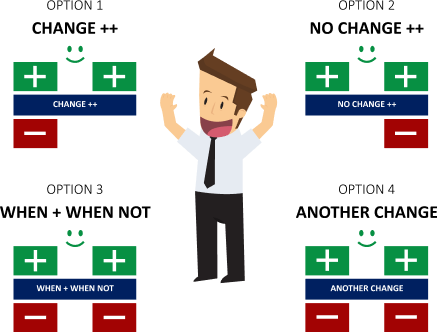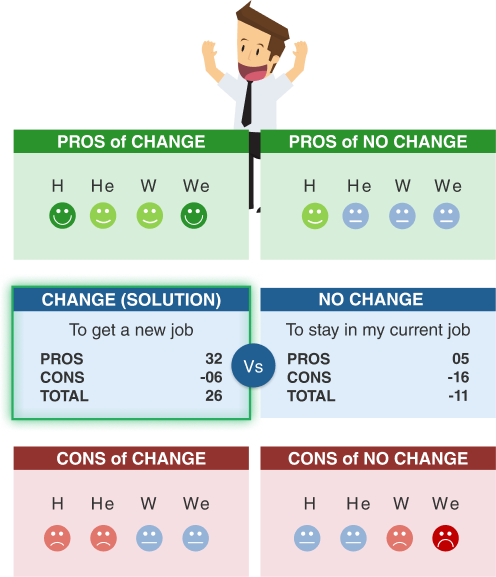






Step 1 – The Why…

Step 1 – The What…
Step 1 is to define YOUR Problem – an important problem you feel responsible for dealing with.
To ensure it is important enough to invest your / your team’s limited attention into resolving, you should define first “Why it’s bad for you?” and then ”Why its bad for other stakeholders?”.
To edit any box, simply touch inside it if you are using a touch device or double click on it or right click and then click on “Edit Title” if you are using a desktop browser. The edit box will appear showing the question you need to answer. Simply type in your answer and then click on “Ok” at the bottom right corner of the Edit box.
Upon completion of all three boxes, click on “Go to Next Step” which will navigate you to Step 2 where you will define the decision you/your team face in dealing with the problem and the decision faced by the one you blame for causing the problem.
Step 1 – The How… (Work Example)

Step 1 – The How… (Home Example)

Step 2a – The Why…

Step 2a – The What…
Step 2a is to define YOUR Decision - the decision you/your team face in dealing with YOUR Problem to prevent mistake of just jumping to a solution.
The “Solution” is the CHANGE part of the Decision, while the NO CHANGE is the STATUS QUO.
In the case where maintaining the STATUS QUO is not an option, the Decision will be between CHANGE vs. ALTERNATIVE CHANGE.
Once you have entered your answers for YOUR Conflicting Tactics, you should define the unique PROS (positives) and unique CONS (negatives) for the CHANGE vs. NO CHANGE.
Then finally, define your GOAL and THREAT. Once completed you can define THEIR DECISION or click on GO TO NEXT STEP to navigate to STEP 3a.
Step 2a – The How… (Work Example)

Step 2a – The How… (Home Example)

Step 3 – The Why…

Step 3 – The What…
Step 3 is how to RESOLVE YOUR AND THEIR Decision with 4 different OPTIONS rather than compromising and giving up PROS you/them WANT to gain or keep and/or retaining CONS you/them DON’T WANT to gain or keep.
The 4 options include:
- Option 1) CHANGE++: What can you add to retain + of NO CHANGE (1st +) and not gain – OF CHANGE (2nd +)
- Option 2) NO CHANGE++: What can you add to gain + of CHANGE (1st +) and to lose – OF NO CHANGE (2nd +)
- Option 3) WHEN + WHEN NOT: When should you CHANGE + When should you NO CHANGE/use ALTERNATIVE
- Option 4) ANOTHER CHANGE: What other change can get you more PROS and less CONS.
Step 3 – The How…

Step 4 – The Why…

Step 4 – The What…
Step 4 is to identify all the “Yes, buts” you and/or other stakeholders might have that can block or distract you from implementing your decision resolutions without compromising.
For the Option you selected to resolve your decisions, identify 3 types of Yes, buts.
- Resolution is not sufficient to be a win for all stakeholders.
- Resolution has potential negatives for one or more stakeholders.
- Resolution has implementation obstacles.
For each “Yes, but”, click on the relevant text box, enter the stakeholder that raised it, what the “Yes, but” is, and the “Yes, And” to overcome it.
Once completed click on GO TO NEXT STEP to move to Step 5.
Step 4 – The How… (Work Example)

Step 4 – The How… (Home Example)

Step 5 – The Why…

Step 5 – The What…
Step 5 is the final step where HARMONY DECISION MAKER automatically summarizes your full analysis into a “Experiment Design” format that clearly answers the WHAT FOR, HOW TO and WHY’s related to your new Decision Resolution.
WHY#1 is a summary of Step 1 to answer why a change is needed.
WHAT FOR is a summary of the PROS you want to gain and retain and CONS you don’t want to gain and retain to answer what the objective is of the new change
WHY#2 is a summary of assumptions challenged in Step 3 and YES, BUTS that needed to be overcome in Step 4.
HOW TO is a summary of the full Tactic from Step 3 and 4.
You can edit any box by clicking on it.
Step 5 – The How… (Work Example)

Step 5 – The How… (Home Example)

Just do it – The Why…

Just do it – The What…
The last step is called “Just Do it!”. You have now completed all 5 steps of your analysis and have done the best possible analysis and preparation to identify a NEW CHANGE to solve your problem.
But unless you actually implement it, you will never know if it would work or not. In this final step, you will monitor and report the project status of your experiment.
Your project can be in one of 5 states:
- NS – Not Started
- IP – In Progress
- F – Frozen
- C – Completed Implementing Change/Tactic.
- A – Achieved Objective/Strategy
"F" is used when you want to stop multitasking to focus on a higher priority project. As the status changes, click on the new Status to show your progress to other stakeholders.
Just do it – The How…











Are YOU facing a difficult decision?
determined by a SIMPLE formula.
Event + Response = Outcome
You cannot control Events.
You can only control your Response.
You must DECIDE how to RESPOND
to get the positive OUTCOME you want.


Why is it so difficult to decide HOW to respond?
There are 3 reasons it is difficult:
- We often REACT, we do not RESPOND, so can over-react or under-react
- There are always 2 Responses and each Response has unique Pros and Cons (+ Outcomes and - Outcomes)
- This puts us in a Decision Conflict


How can HARMONY help you make a good decision?
We designed the HARMONY App to guide you through 5 steps, each designed to help you avoid the 5 most common decision mistakes. It will allow you to make difficult decisions, better, faster and with confidence.


How can YOU avoid the mistake of REACTING?
To avoid either OVER- OR UNDER-REACTING, we should validate that the Positive or Negative Event (Problem) we feel pressure to respond to, is really important to us, and those we care about.


How to UNDERSTAND YOUR conflict & need?
To avoid just jumping to a solution, we should list BOTH options we have on how to RESPOND (the conflict) and for each option, list both the unique PROS you want and unique CONS you don’t want (the need).


How to find a win:win to RESOLVE your conflict?
To avoid having to live with any CONS or lose out on any PROS (the need), Harmony will guide you to create 4 win:win Resolutions so you can select the one with the most PROS and least CONS


How to ensure your solution will not FAIL?
To avoid the risk of your selected breakthrough failing, you and other people involved, should raise as many “Yes-Buts” and how to overcome these (the Yes-Ands) that can be added to your solution to reduce the risk of a bad outcome.


How to test your solution with an EXPERIMENT?
To avoid investing too much time and/or money before knowing whether your solution will actually work, Harmony will create a summary of the Why, What and How of your analysis to share with others that can help you test it with an experiment.


How to SHARE and LEARN from others
To collaborate and get feedback or allow others to learn from your experience, you can share your analysis via the Harmony App. If you do get stuck, you can also go to the Community Library to learn from other users that shared their analysis.


Ready to make your first decision with Harmony?
All you need to start, is an important problem or opportunity you are facing, that is putting pressure on you to make a decision. Once you are ready, click on the “+”


|
Process Steps
|
Progress Status

My Decision Libraries
The “Analyze it” ProConCloud method will help you make a better faster decision by enabling you to discover 4 new win:win options to achieve MORE Pros and LESS Cons than either of the 2 options you have considered so far (e.g CHANGE vs. NO CHANGE). This method is great to help you find and overcome self-limiting assumptions or beliefs.

The "Calculate it” ProConCloud method will help you make a better faster decision by enabling you to calculate the BEST of two options based on the BEST vs. WORST case impact of each option on the decision criteria you think is important to consider. This method is great to help you make complex decisions with multiple decision criteria each with their own level of importance.
Import list of users:
Download Template
Please, import text file (.txt, .csv and etc) with the list of emails.
You successfully shared this item to specified users.
In case users are not subscribed to Harmony, they will receive invitation message. OK |
|
|
|
|
"" by ,
|
|
| Last Edit By | |
| Created Date | |
| Last Saved On Client Date | |
| Last Send To Server Date | |
| Rights | |
| Local storage usage | MB |
| - | - |

